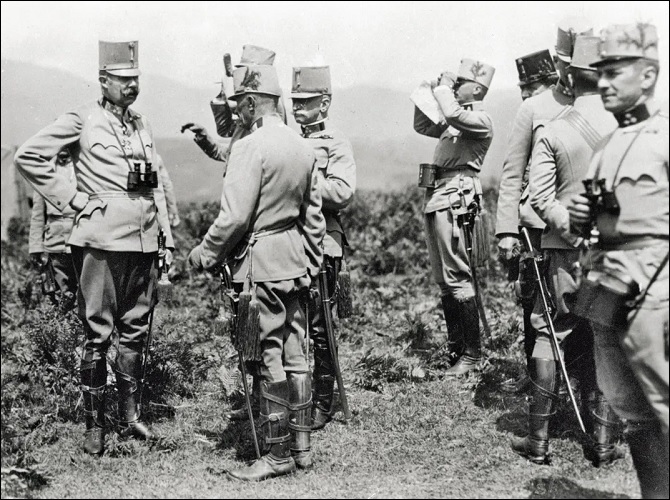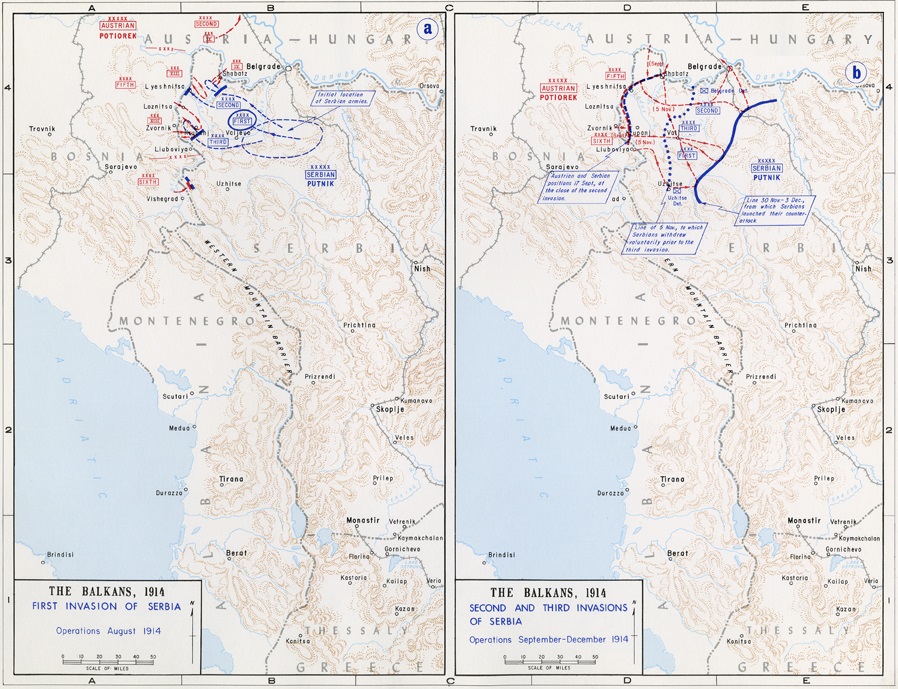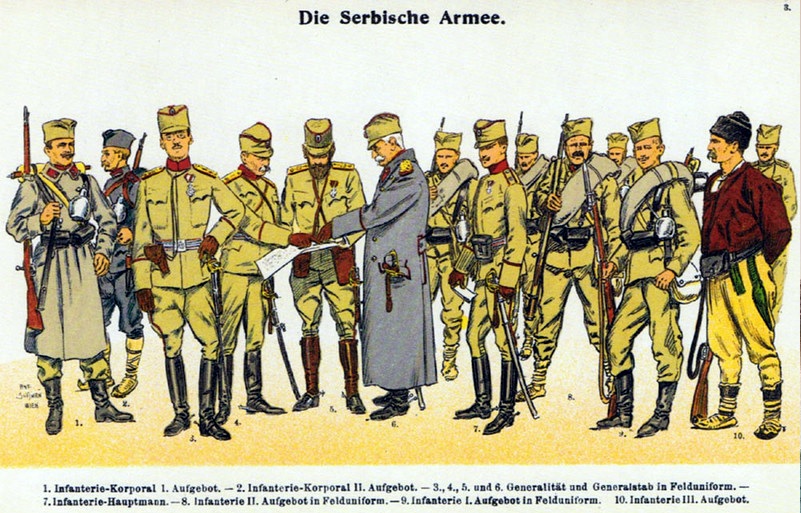● ● ●
For
clarity, Austro-Hungarian units are rendered in italics.
Though Germany had scored a
notable victory in East Prussia, it was severely tempered if
not negated by the disasters that engulfed the armies of the
Habsburg Monarchy.
The prewar agreement between
the German and Austro-Hungarian general staffs had provided
for an Austrian offensive in Galicia—this to relieve
pressure on the scanty German forces defending East Prussia.
Such an offensive would necessitate the deployment of the
bulk of the Austro-Hungarian Army in Galicia, leaving
minimal forces to screen Serbia. But the Austrian Chief of
Staff, General Count Franz Conrad von Hötzendorf, was ill
content with this arrangement. Though Russia posed the most
serious military threat, he and most leading figures of the
Habsburg Monarchy viewed Serbia’s pan-Slavic aspirations as
an even greater menace. The Serbs’ desire to unite the south
Slavs in a single kingdom under their leadership implied the
demise of the Monarchy. Thus Conrad was determined to
“strike down Serbia with rapid blows” while standing on the
defensive in Galicia—this despite his promise to the
Germans. But the Austrian Chief of Staff's duplicity only
succeeded in making a muddle of his army's mobilization.
For purposes of
mobilization, the Austro-Hungarian Army was divided into
three contingents. A-Staffel (thirty infantry divisions
plus cavalry) was earmarked for Galicia. Minimalgruppe
Balkan (eight divisions plus cavalry) was earmarked for the
Serbian front. B-Staffel (ten divisions plus cavalry)
was the strategic reserve. In the event of a limited war
between Austria and Serbia, it would reinforce
Minimalgruppe Balkan. If Russia entered the war, it
would join A-Staffel in Galicia.
But Conrad's desire to
strike at Serbia upended this arrangement. When mobilization was
ordered, B-Staffel (Second Army), was
initially directed against Serbia. Then German protests over
his failure to launch the agreed-upon Galician offensive
compelled Conrad to attack there after all. The Chief of
Staff therefore redirected Second Army to Galicia.
But the chief of the mobilization section of the General
Staff protested that such a last-minute change would cause
chaos on the rail system. Second Army would have to
go to the Serbian front anyway, there to await the clearance
of the rail lines. Not until 16 August would it be possible to
get the army on the move to Galicia. In the meantime it was
partly drawn into the Serbian invasion and, thanks to the
ill success of the Austrian offensive, when the time came to
move north one-third of it (IV Corps with three
divisions) had to be left behind. Thus Second Army
arrived in Galicia both late and under strength.

August 1914: An
Austro-Hungarian general (left) and his staff
(Heeresgeschichtliches
Museum)
The Austrian commander on
the Serbian front, General of Artillery Oskar Potiorek, was
eager to present the Emperor Franz Joseph with a victory for
his birthday (18 August). He therefore launched his
offensive on 12 August with Fifth Army (under his
personal command) and elements of Second Army
(General of Cavalry Eduard Freiherr von Böhm-Ermolli).
Sixth Army (General of Cavalry
Liborius Ritter von
Frank)
had not yet completed its concentration.
Fifth Army had four infantry divisions, two infantry
brigades, a mountain brigade, a Landstrum (militia)
brigade and some cavalry. Second Army committed its
IV Corps (three infantry divisions). The grand total
was about 285,000 men. Potiorek exuded confidence, imagining
that his troops would easily rout the primitive and
ill-equipped Serbs, whom he scorned as an army of "pig
farmers." But his confidence was badly misplaced. It was
true that the Serbian Army was short of modern weapons and
even boots for its soldiers, but it was a battle-hardened
force under a skilled and redoubtable commander, Marshal
Radomir Putnik. His forces were divided into three field
armies, (actually the size of corps) with a variable number
of divisions and brigades, totaling about 250,000 men.
The Austrian offensive made good
progress at first, the concentric attacks of Fifth Army
and IV Corps forcing the Serbs from one position
after another. Belgrade, the Serbian capital, was close the
Austrian border and poorly fortified; it soon fell. But as Putnik withdrew
he
concentrated his army in preparation for a
counterattack. This was delivered on 15 August in the
vicinity of Cir Mountain, primarily
against Fifth Army. The Austrian positions on the
slope of the mountain were lightly held and they
were forced back. Three days of heavy fighting followed with
high casualties on both sides, and ultimately Potiorek was
compelled to order a general retreat. Fifth Army was
shattered: Some 38,000 men had been killed or wounded, with
another 4,000 taken prisoner. Many of its units had lost all
cohesion. The Serbs too suffered heavily, with some
5,000 killed and 15,000 wounded. But by 20 August the
Austrians had been chased entirely out of Serbia—a painful
setback for a country that still counted itself a great
power.
At the urging of the
Russians, the Serbs followed up on their victory with an
invasion of Bosnia. The idea was to prevent the transfer of
Second Army to Galicia, but by the time Putnik
commenced his attack the Austrians were gone. The Serbian
First Army did gain a foothold in Bosnia but this position
had to be abandoned when the Austrians mounted their second
invasion.

Department of History, USMA West Point
Early in September Potiorek
tried again, attacking with the reorganized and reinforced
Fifth Army and Sixth Army. The former,
attacking across the Drina River as it had in August, was
repulsed. But farther south the stronger Sixth Army
(five infantry divisions, one Landstrum brigade and some
cavalry) had better luck. It managed to establish itself on
Serbian territory and its success also levered the Serbian
forces facing Fifth Army out of their positions. The
fighting again was fierce, with each side suffering heavy
casualties before a stalemate was reached. There followed a
month and a half of static trench warfare. In November, the
Austrians opened a new offensive but after an encouraging
start it broke down in the face of a Serbian counterattack
that shattered Sixth Army. When the fighting subsided
in early December, no Austrian soldiers, prisoners of war
excepted, remained on Serbian soil. The
debacle being complete, the hapless Potiorek—who as military
governor of Bosnia had presided over the assassination of
the Archduke Franz Ferdinand—was relieved of his command.
Ritter von Frank, the commander of Sixth Army, was
also sacked.
While
Potiorek’s initial operations in Serbia were proceeding on their
lamentable course, the main body of the Austro-Hungarian
Army, A-Staffel with some thirty infantry divisions and
eight
cavalry divisions, was being deployed in Galicia. From left
to right, these forces were allotted to First Army, Fourth
Army and Third Army . By late August they had completed their march to
the frontier (necessitated by Conrad’s earlier decision to
stand on the defensive inside Galicia) and were ready to
attack.
Conrad’s
plan, sound enough in principle, was to advance north-east
into Russian Poland with the two armies of his left wing,
capturing the towns of Lubin and Chom, unhinging the
Russians' right flank and compelling them to withdraw. But
thanks to Second Army’s non-appearance, there were
insufficient troops to carry out the operation. As First and Fourth Armies
advanced, the right flank of the latter would be
increasingly exposed. It was to have been the task of
Second Army and Third Army to screen this
exposed flank. But for the latter alone, this proved to be a
mission impossible. Conrad was all too well aware of the
unpalatable facts: that
Russian mobilization would inevitably bring more and more
divisions into the line against the Austrian armies, and
that
thanks to Second Army’s late arrival the resultant
pressure on the Austrian right flank was bound to reach
crisis proportions.
Nevertheless Conrad persisted and the general
Austro-Hungarian offensive in Galicia commenced on 22 August
1914.



